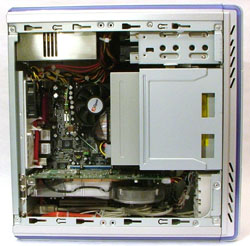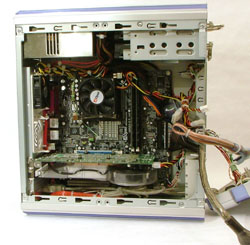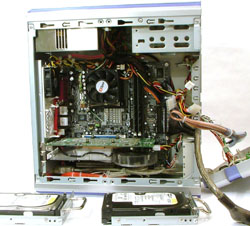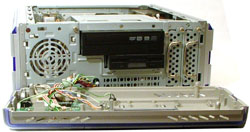System Review – PC-Club Silencer
by Jarred Walton on March 28, 2005 12:05 AM EST- Posted in
- Systems
Construction and Setup
The overall external build quality is generally good. Long-term durability should present no problem, although the case did have/develop a few scratches. It arrived at our location with some areas on the sides where the silver paint had worn off as well as a small ding. We're not sure if these happened during construction, with a previous reviewer, or perhaps due to our own negligence in handling the case, but we mention them nonetheless. As with most computer equipment, we would advise some care in handling the system. Hopefully, such blemishes are not coming from PC-Club, and we'll give them the benefit of the doubt. As we move to the internals, remember that our comments here will only affect you should you choose to try and upgrade the system, so we're not terribly concerned with the flaws in the internal design.   |
| Click images to enlarge. |
Once we open up the case, we encounter some good design aspects as well as some potential problems. On the good side of things, we have thumbscrews used for several items. Two secure the cover, and there are two more each for the optical/floppy bay, and each hard drive cage. The use of drive cages is also convenient, as it becomes easier to mount the HDDs without worrying about cables or other items getting in the way. The only complaint we had was that getting the cables connected to the rear of the drives was a little tricky in the cramped confines of the case. A little more slack on the SATA power and data cables would have helped, but that might also get in the way of airflow once the drives are secured in place.
 |
 |
| Click images to enlarge. | |
All is not well with the HDD setup, however. It's no secret that heat helps to kill hard drives. Last summer, in 100 F weather and a house without AC, I had a six-month-old Samsung HDD fail on me. It was placed in an Antec case with two other drives, and even the presence of a fan in front of the drives wasn't enough to keep them cool. We generally like to have at least a centimeter of open space above and beneath our hard drives, and a low RPM fan in front of the drives helps. The case does not have a fan at this location, although the power supply should provide for some circulation. As for proximity, with both hard drive bays filled, there is very little room for air circulation. We didn't have any issues during testing, but we were only using the system for a few weeks as opposed to months, so problems aren't likely to occur. Long-term - particularly in areas that get hot during the summer months - we are very concerned with the use of a 10,000 RPM Raptor in such a cramped space. Should you choose to purchase such a system from PC-Club, our advice would be to stick with two 7200 RPM drives at most, preferably models with fluid dynamic bearings. They're quieter and run cooler, which seems to be the better fit for such a system.
In a similar vein to the HDD heat concerns, the location of the RAM is right underneath the optical drive - completely obscured by the drive, in fact. Air flow to this area will not be very good; although with the maximum of two DIMMs, things should be okay. The inclusion of CL2.5 Mushkin RAM may be intended to lower heat output, and even with a 3:5 memory ratio, the RAM will be run at PC2700 speeds and overclocking won't get the RAM up to more than PC3200 speeds. We would be more concerned if there were four DIMMs and faster memory could be used, but in this design, the relatively confined quarters for the RAM shouldn't matter too much.
There are some other issues near the RAM, however. The floppy and IDE cables in the area create more "clutter", and while rounded cables help somewhat, they're on the long side. We would prefer the use of some shorter IDE cables instead. There is no room for a second IDE device near the DVD+RW, so a short, flat IDE cable would tuck away quite nicely, and the same goes for the floppy cable. Shuttle and several other SFF manufacturers have such cables, and even though PC-Club may not manufacture most of their components, procuring different cables should be simple to do. (The unit arrived with the floppy cable detached, incidentally - it appears to have come loose during shipping, likely due to the length and weight. Perhaps shorter cables would have avoided this problem.) One of the advantages of a pre-built system is that the system integrator should be able to tailor the build to the specific needs, and we don't think that PC-Club did as well as they could have in this instance.
Another minor concern with the construction is that the removal of the optical and floppy drive cage is a little... ungraceful. It works okay, but it could be better. The problem stems from the fact that you have to remove the front panel of the case, which is secured by plastic tabs. Once we figured out how to remove the front panel (the top-left plastic hook actually needs to be depressed from inside the case, whereas the other three corners simply pull out with a bit of force), we could work with the internals. However, the front panel has quite a few wires connected to it, so you end up with them hanging around as you install the hard drives and other parts. The internal structure of the case - specifically the CD/floppy cage - also feels a bit flimsy, particularly when the screws are not in place. It doesn't seem to be a problem when everything is connected and the cover is on, but long-term durability might not be the greatest. If you were to upgrade components regularly, the cage mechanism and front panel would be pretty irritating, as they cover the RAM. We noticed this as we ran several different configurations inside the case. We feel that this will only be a concern for users who purchase such a system and then decide to upgrade it themselves. Realistically, the only likely upgrade for such people would be a second HDD installed at a later date.
The final point that we would like to make on the construction has to do with the fans. We are not advocates of smaller fan sizes; quite the opposite, in fact. Obviously, you can't always fit a 120mm or even 80mm fan in every chassis, but the Athenatech case included one 40mm fan in the rear with space for a second fan to be added. The 40mm fan was spliced into the same power source as the CPU fan, allowing both fans to run off of one source. While the CPU fan was a 60mm model that spun at a low RPM and was nearly silent, the same cannot be said of the 40mm fan. It was by far the largest noise source in the system. After consulting with PC-Club, we unplugged the fan and were much happier with the result. Perhaps a different fan would generate less noise, and PC-Club says that the fan is not necessary, especially if you go with a single hard drive configuration. That would be our advice as well. For those who want to go to the other extreme, you could add a second 40mm fan in the rear as well as an 80mm fan on the front panel behind the LCD. We're not sure why you would want to do that, but the case does allow for it.
Overall, then, the construction of the case has a few minor problems. If PC-Club were designing their own cases, power supplies, and motherboards, we would suggest some alterations to the design. However, as they are simply a system builder, there's not much that they can do other than select different components. If you were to remove the optical drive and hard drives frequently, it would be very annoying. For the intended customers, it's not really a problem. Most users aren't going to open a system such as this and play with all the internals the way that we at AnandTech tend to do, and with PC-Club doing the system setup, you should be fine. We just wouldn't want to be the ones on the PC-Club assembly line, although we'd probably say that about any assembly line job.











22 Comments
View All Comments
QueBert - Monday, March 28, 2005 - link
In Russia, PC Silences you...QueBert - Monday, March 28, 2005 - link